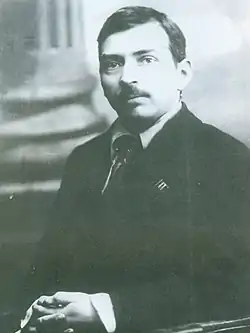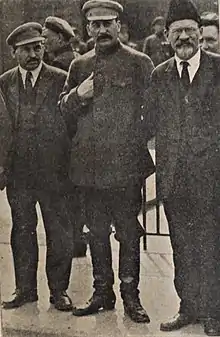Mikhail Tomsky
Mikhail Pavlovich Tomsky (Russian: Михаи́л Па́влович То́мский, born Mikhail Pavlovich Yefremov – sometimes transliterated as Efremov; Михаи́л Па́влович Ефре́мов; 31 October 1880 – 22 August 1936) was a factory worker, trade unionist and Bolshevik leader and Soviet politician. He was the chairman of the All-Russian Central Council of Trade Unions.
Mikhail Tomsky Михаил Томский | |
|---|---|
 Tomsky as head of the trade union movement, 1920s | |
| Chairman of the Presidium of the All-Union Central Council of Trade Unions | |
| In office September 1922 – May 1929 | |
| Preceded by | Post established |
| Succeeded by | Alexander Dogadov |
| Secretary of the Central Executive Committee of the All-Russian Congress of Soviets | |
| In office 29 December 1921 – 28 December 1922 | |
| Preceded by | Pyotr Zalutsky |
| Succeeded by | Timofei Sapronov |
| General Secretary of the International Trade Union Council | |
| In office 1920 – 3 July 1921 | |
| President | Solomon Lozovsky |
| Preceded by | Post established |
| Succeeded by | Post abolished |
| Full member of the 11th, 12th, 13th, 14th, 15th Politburo | |
| In office 3 April 1922 – 13 July 1930 | |
| Full member of the 10th, 11th, 12th Orgburo | |
| In office 16 March 1921 – 2 June 1924 | |
| Candidate member of the 9th, 13th Orgburo | |
| In office 2 June 1924 – 1 January 1926 | |
| In office 5 April 1920 – 16 March 1921 | |
| Personal details | |
| Born | 31 October 1880 Kolpino, Saint Petersburg Governorate, Russian Empire |
| Died | 22 August 1936 (aged 55) Bolshevo, Moscow Oblast, Russian SFSR, Soviet Union |
| Political party | RSDLP (Bolsheviks) (1904-1918) Russian Communist Party (1918-1936) |
| Occupation | Trade unionist |
Tomsky attempted to form a trade union at his factory in St. Petersburg resulting in his dismissal.[1]
His labour activities radicalized him politically and led him to become a socialist and join the Russian Social Democratic Labour Party in 1904 and eventually join the Bolshevik faction of the party. During the Great Purge, he was accused of faulty charges and put on a show trial being accused of terrorism and sabotage. Mikhail Tomsky would later commit suicide to avoid arrest by the KGB in August 1936.
Early life (1880–1920)
Born in Kolpino, Saint Petersburg Governorate in a lower-middle-class family of Russian ethnicity,[2] Tomsky moved to Estonia (then part of the Russian Empire) and was involved in the 1905 Revolution. He helped form the Revel Soviet of Workers' Deputies and the Revel Union of Metal Workers. Tomsky was arrested and deported to Siberia.
He escaped and returned to St. Petersburg where he became president of the Union of Engravers and Chromolithographers.
Tomsky was arrested in 1908 and then exiled to France, but returned to Russia in 1909 where he was again arrested for his political activities and sentenced to five years of hard labour. He was freed by the Provisional Government after the February Revolution in 1917 and moved to Moscow where he participated in the October Revolution. In 1918 he attended the Fourth All Russian Conference of Trade Unions (12–17 March), where he moved a resolution concerning the Relations between the Trade Unions and the Commissariat for Labour which stated that the October Revolution had changed "the meaning and character of state organs and significance of proletarian organs as well". It was elaborated that previously the old ministry of Labour had acted as arbitrator between Labour and Capital, whereas the new Commissariat was the champion of the economic policy of the working class.
Career (1920–1928)

He was elected to the Central Committee in March 1919, to its Orgburo in 1921 and to the Politburo in April 1922.
Tomsky was an ally of Nikolai Bukharin and Alexey Rykov, who led the moderate (or right) wing of the Communist Party in the 1920s.
Together, they were allied with Joseph Stalin's faction and helped him purge the United Opposition - led by Leon Trotsky, Lev Kamenev, and Grigory Zinoviev - from the Party during the struggle that followed Lenin's death in 1924.
Demise (1928–1936)
In 1928 Stalin moved against his former allies, defeating Bukharin, Rykov and Tomsky at the April 1929 Plenary Meeting of the Central Committee and forcing Tomsky to resign from his position as leader of the trade union movement in May 1929. Tomsky was put in charge of the Soviet chemical industry, a position which he occupied until 1930. He was not re-elected to the Politburo after the 16th Communist Party Congress in July 1930, but remained a full member of the Central Committee until the next Congress in January 1934, when he was demoted to candidate (non-voting) member.
Tomsky headed the State Publishing House from May 1932 until August 1936, when he was accused of terrorist connections during the First Moscow Trial of Zinoviev and Kamenev. Rather than face arrest by the NKVD, Tomsky committed suicide by gunshot in his dacha in Bolshevo, near Moscow.[1] He was posthumously accused of high treason and other crimes during the third (March 1938) show trial of Bukharin, Rykov and others. The Soviet government cleared Tomsky of all charges during perestroika in 1988.
Sources
- "Tomsky". Archived from the original on 2010-12-09. Retrieved 2011-02-20..
Bibliography
- Kaplan, Frederick (1968). Bolshevik Ideology and the Ethics of Soviet labor. Philosophical library, New York.
- Politicheckie deyateli Rossii 1917: Biograficheskij slovar'. Moscow, 1993. Excerpts available online.
- Robert C. Tucker, Memoir of a Stalin Biographer
External links
- Works by or about Mikhail Tomsky at Internet Archive
- Tomsky Archive Marxists Internet Archive
- The trade unions, the party and the state a pamphlet by Tomsky